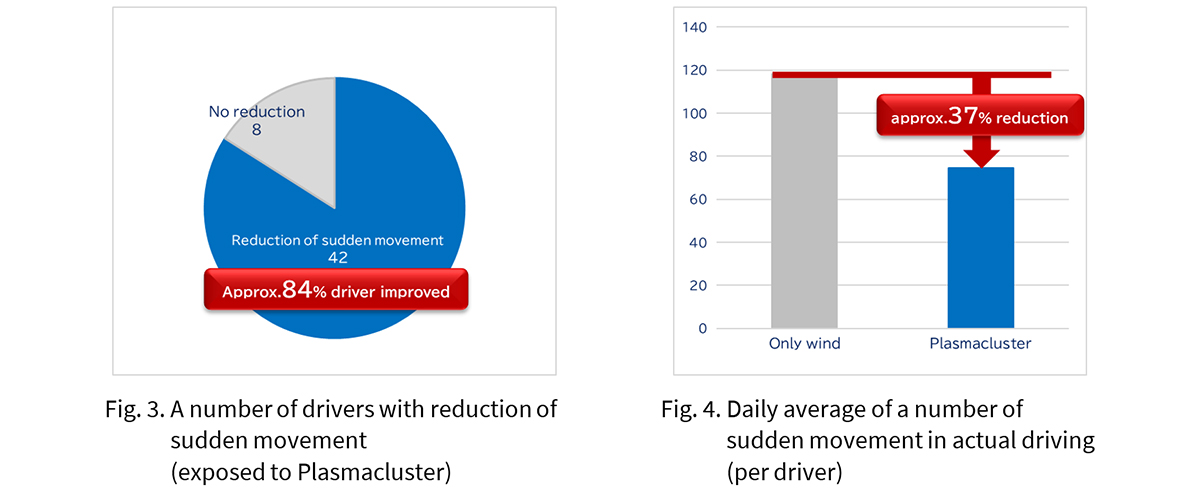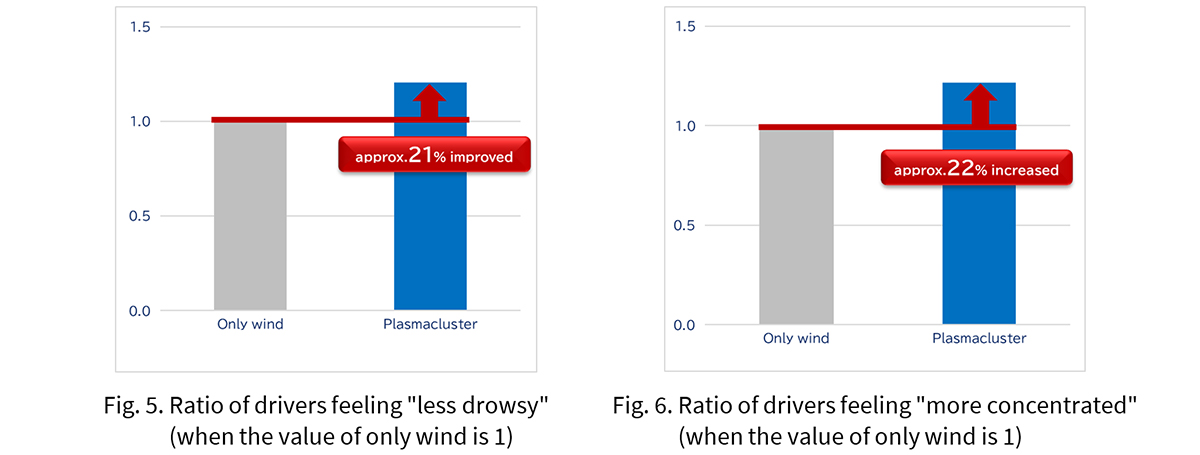Sharp Corporation, under the supervision of Dr. Toshio Ito (Former Professor at Shibaura Institute of Technology), CEO of Hyper Digital Twins Co., Ltd.*3, a company specializing in driving assistance research, has verified the efficacy of our Plasmacluster technology in improving the driving ability of people while operating an actual vehicle based on the G-force sensor*4 of a video drive recorder. As a result, we have demonstrated for the first time in the world that exposing people to Plasmacluster ions improves their driving ability even when operating an actual vehicle.
In a study conducted in 2023 using a driving simulator, Sharp demonstrated that Plasmacluster technology can improve driving ability (reduced stopping distance, smoother steering, and reduced drowsiness)*5 during both manual and automated driving.
In this current study, we tested whether exposing the driver to Plasmacluster ions would improve the driving ability of 50 drivers of a local ride-sharing company in Ho Chi Minh City, Vietnam, a location with heavy traffic volumes where a high level of concentration may require for driving. As a result, we confirmed that sudden movements such as sudden braking and swerving by the driver were reduced in 84% of drivers overall, and that sudden movements by drivers per day were reduced by an average of approximately 37%. Additionally, the results of a driver survey confirmed that approximately 21% of drivers felt that their drowsiness was reduced and that they were able to drive in a more alert state than usual, and approximately 22% of drivers felt that they were able to maintain a higher level of concentration than usual.
In this study, we were able to confirm the possibility of effectiveness in improving driving ability while operating an actual vehicle, both in terms of objective evaluation and the driver’s subjective evaluation. We believe that the results of this research, which showed that Plasmacluster technology has the capability of preventing distracted driving which may lead to fatal accidents, are of great significance.
Plasmacluster technology is an air purification technology that uses the same positive and negative ions as those present in nature and a high level of safety and various effectiveness have been confirmed for more than 20 years. This time, Sharp has newly demonstrated the effectiveness of Plasmacluster technology on improving driving ability in actual traffic condition, and Sharp will continuously conduct the verification of the effectiveness and its mechanism against the human being to enhance its reliability, and will study the additional effectiveness and applicability of Plasmacluster technology to the new field.
Comment from Dr. Toshio Ito (CEO of Hyper Digital Twins Co., Ltd.)
This verification confirmed that exposing a driver to Plasmacluster ions while driving an actual vehicle reduces drowsiness, maintains concentration, and by reducing sudden driving movements, improves driving ability. This result supports previous research*5, and it is believed that Plasmacluster ions maintain and improve concentration, allowing the driver to sense danger in advance and drive with ease and comfort. In addition, the fact that these were confirmed in both objective and subjective evaluations provides a certain level of credibility, and it is very interesting that the drivers themselves actually feel these effects. We look forward to additional new effects and development of new applications for Plasmacluster technology in the future.
*1 For an ion-discharge air purification technology (as of October 10, 2024, based on Sharp findings).
*2 Evaluated based on movement of the integrated G-force sensor in the video drive recorder both in the direction of travel (sudden braking) and laterally (sudden swerving).
*3 Startup company from Shibaura Institute of Technology. Develop ultra-compact mobility business by fusion sensor network technology and robotics technology.
*4 Accelerometer detects impact applied to the vehicle body
*5 Announced on September 26, 2023. Confirmed efficacy of Plasmacluster technology in improving driving ability (https://global.sharp/corporate/news/230926-a.html).
● Plasmacluster and the Plasmacluster logos are registered trademarks of Sharp Corporation.
■ Summary of tests to verify the efficacy of Plasmacluster ions in improving driving ability while driving an actual vehicle
●Test organization: Sharp Electronics (Vietnam) Company Limited, supervised by Dr. Toshio Ito (CEO of Hyper Digital Twins Co., Ltd., and Former Professor at Shibaura Institute of Technology)
●Driving location: Public roads in Ho Chi Minh City, Vietnam
●Participants: 50 drivers for a local ride-sharing company in Vietnam
●Test apparatus: Test apparatus equipped with Plasmacluster technology
●Test conditions: a. Without Plasmacluster ions (air flow only)
b. With Plasmacluster ions
●Plasmacluster ion density: Participant location: Approx. 100,000 ions/cm3 or greater
●Test method:
Each driver was equipped with a test apparatus and asked to carry out their activities normally.
After driving for two weeks without Plasmacluster ions (cabin airflow only), they were asked to drive for two weeks with Plasmacluster ions. Driving ability was compared and evaluated based on video drive recorder data and questionnaires obtained during the driving period under each condition.
In addition, a reset period of one week was established between each condition during which the test device was not used. The test was conducted as a single-blind test in which the drivers were not informed of the presence or absence of Plasmacluster ions.

Fig. 1. Installation image
●Questionnaire content:
Drivers were asked to rate the following five items on a five-point scale.
・In-vehicle atmosphere (air feeling) while driving
・Operability while driving
・Mood while driving
・Drowsiness while driving
・Concentration while driving
The survey was conducted four times in total, twice during the driving period under each condition and twice at the end.

Fig. 2. Test flow
●Results:
1. Evaluation results based on objective indicators (count of G-force sensor activations)

Compared to cabin airflow only, the following points were confirmed for cases with Plasmacluster ions.
1) 84% of drivers showed an improvement in reduction of sudden movement by exposing to Plasmacluster. (Fig. 3)
2) Approximately 37% of sudden driving movement on a daily average was reduced per driver by exposing to Plasmacluster. (Fig. 4)
2. Evaluation results based on subjective indicators (questionnaire completed by drivers)

Compared to cabin airflow only, those cases with Plasmacluster ions showed better results in all questionnaire items, the following points in particular, were confirmed to have significant changes.
3) Approximately 21% of drivers felt “less drowsy” by exposing to Plasmacluster. (Fig. 5)
4) Approximately 22% of drivers felt “more concentrated” by exposing to Plasmacluster. (Fig. 6)
The above results confirmed that Plasmacluster technology has the effect of improving driving ability while driving an actual vehicle.
■ Research Institutes That Provided Data for Sharp’s Academic Marketing
|
Target |
Testing and Verification Organization |
|
Efficacy proven in clinical trials |
Shibaura Institute of Technology, College of Systems Engineering and Science, Department of Machinery and Control Systems |
|
Kyushu Sangyo University, Department of Sport Science and Health, Faculty of Human Sciences | |
|
National Institute of Fitness and Sports in Kanoya | |
|
Littlesoftware Inc. | |
|
Dentsu ScienceJam Inc. | |
|
Graduate School of Medicine, University of Tokyo / Public Health Research Foundation | |
|
Faculty of Science and Engineering, Chuo University / Clinical Research Support Center, University Hospital, University of Tokyo | |
|
National Center of Tuberculosis and Lung Diseases, Georgia | |
|
Animal Clinical Research Foundation | |
|
Soiken Inc. | |
|
School of Bioscience and Biotechnology, Tokyo University of Technology | |
|
National Trust Co., Ltd. / HARG Treatment Center | |
|
Working mechanism of its enhancing effect on work performance |
Kyushu Sangyo University, Department of Sport Science and Health, Faculty of Human Sciences |
|
Working mechanism of inhibitory effects on viruses, fungi, and bacteria |
Professor Gerhard Artmann, Aachen University of Applied Sciences, Germany |
|
Working mechanism of inhibitory effects on allergens |
Graduate School of Advanced Sciences of Matter, Hiroshima University |
|
Working mechanism of skin moisturizing (water molecule coating) effect |
Research Institute of Electrical Communication, Tohoku University |
|
Viruses |
Kitasato Research Center of Environmental Sciences |
|
Seoul National University | |
|
Shanghai Municipal Center for Disease Control and Prevention, China | |
|
Kitasato Institute Medical Center Hospital | |
|
Retroscreen Virology, Ltd., UK | |
|
Shokukanken Inc. | |
|
University of Indonesia | |
|
Hanoi College of Technology, Vietnam National University, Vietnam | |
|
Institut Pasteur, Ho Chi Minh City, Vietnam | |
|
National Research Center for the Control and Prevention of Infectious Diseases, Institute of Tropical Medicine, Nagasaki University | |
|
Department of Microbiology, Shimane University, Faculty of Medicine | |
|
Columbia University, Department of Medicine | |
|
Fungi |
Ishikawa Health Service Association |
|
University of Lübeck, Germany | |
|
Professor Gerhard Artmann, Aachen University of Applied Sciences, Germany | |
|
Japan Food Research Laboratories | |
|
Shokukanken Inc. | |
|
Shanghai Municipal Center for Disease Control and Prevention, China | |
|
Biostir Inc. | |
|
Medical Mycology Research Center, Chiba University | |
|
Bacteria |
Ishikawa Health Service Association |
|
Shanghai Municipal Center for Disease Control and Prevention, China | |
|
Kitasato Research Center of Environmental Sciences | |
|
Kitasato Institute Medical Center Hospital | |
|
Dr. Melvin W. First, Professor Emeritus, Harvard School of Public Health, US | |
|
Animal Clinical Research Foundation | |
|
University of Lübeck, Germany | |
|
Professor Gerhard Artmann, Aachen University of Applied Sciences, Germany | |
|
Japan Food Research Laboratories | |
|
Shokukanken Inc. | |
|
Chest Disease Institute, Thailand | |
|
Biostir Inc. | |
|
Allergens |
Graduate School of Advanced Sciences of Matter, Hiroshima University |
|
Department of Biochemistry and Molecular Pathology, Graduate School of Medicine, Osaka City University | |
|
Safety |
LSI Medience Corporation |
|
Evaluation of effects on cells |
Columbia University, Department of Medicine |
|
Odors, pet smells |
Boken Quality Evaluation Institute |
|
Animal Clinical Research Foundation | |
|
Skin beautifying effects |
School of Bioscience and Biotechnology, Tokyo University of Technology |
|
Hair beautifying effects |
Saticine Medical Co., Ltd. |
|
C.T.C Japan Ltd. | |
|
Plant |
Facility of Agriculture, Shizuoka University |
|
Hazardous chemical substances |
Sumika Chemical Analysis Service Ltd. |
|
Indian Institutes of Technology Delhi |


 Choose
Choose
